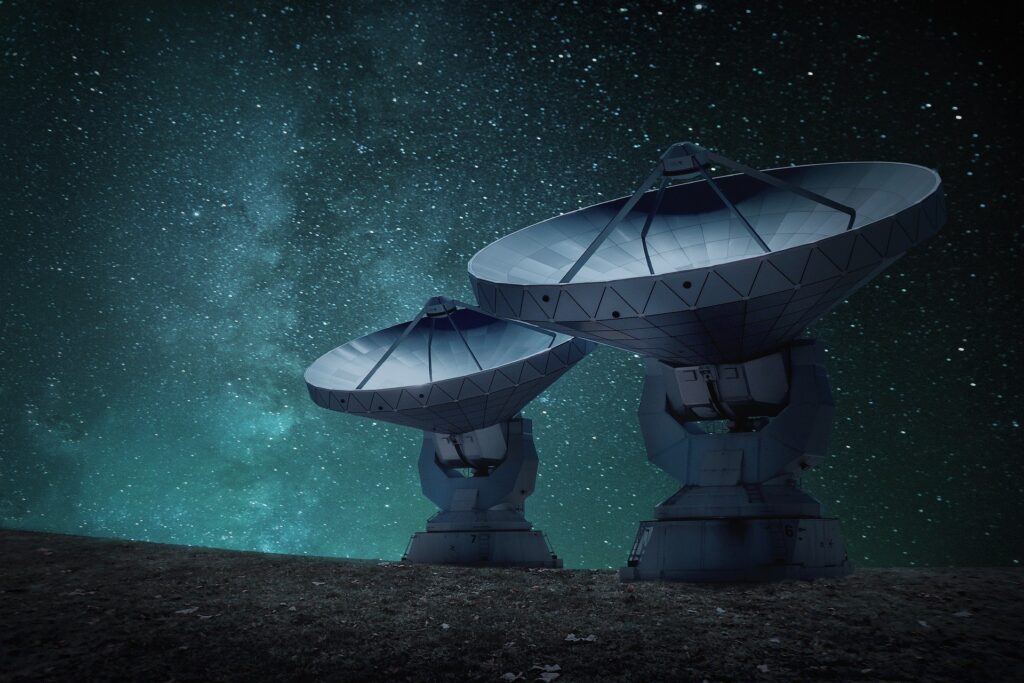In all the years that research has existed in the world, space research has always been one of the most promising and curiosity-filled fields. The concept of studying galaxies, stars, and planets in order to deduce information about them has enormous potential. According to documented history, Africa was a pioneer of space research, as evidenced by the ancient library of Alexandria in Egypt that housed the first space research centre more than two thousand years ago. While there has yet to be an African-born astronaut in space, projects across the continent, particularly in the realms of satellites and telescopes, are on the rise. Space programs on the continent are worth more than $7 billion, according to the consulting firm Space in Africa, and countries including Egypt, Nigeria, South Africa, Angola, Kenya, Ethiopia, and Rwanda have formed or expanded their space agencies in the previous 20 years.
The Square Kilometer Array is one such initiative that aims to put Africa on the map of space exploration.
This project will assist survey our skies faster than ever before, thanks to the collaboration of South Africa’s scientific societies and the country’s government. The Square Kilometer Array is a multi-nation radio telescope project currently under construction in Australia and South Africa. The project originated in the early 1990s and was further finalized in the late 2010s. When this project is finished, it will be able to function across a wide frequency range, making it 50 times more sensitive than any previous radio device.
The project’s operation will require high-performing, major computing engines with greater capacity than the global Internet traffic. It will take advantage of radio astronomy’s potential to produce the most detailed images in all astronomy. According to the organizers of the project, when the project is completed as planned, it will survey the sky more than ten thousand times faster than before. This amplified telescope technology will help astronomers to survey the skies better and analyze its constituents. News has also been heard that upon completion, the entire region that these telescopes will occupy will be 11,000,000 square feet, which is enormous. With receiving stations extending out to 3,000 kilometers, radio astronomy will be exploited to the maximum to study the celestial bodies in the sky and beyond.
Why South Africa is involved in this program
Around 2010, many countries had shown their interest in obtaining the bid for this project. However, in November 2011, the SKA Organization was formed as an intergovernmental organization, and the project moved from collaboration to an independent, non-profit company. The following year, the SKA Site Advisory Committee made a confidential report that the South African bid was more substantial. The selection of South Africa and Australia for the project’s location was mainly due to the ideal view of the Milky Way Galaxy, with radio interference being the least in that region. The project aims to become a catalyst for science, technology, engineering business opportunities, jobs and innovation, and has the potential to put Africa on the map of macro-data transfer and analytics hub. Another primary reason South Africa was chosen for this project, apart from its geographical convenience, is its research capacity in astronomy that has become advanced in human resources and can promote world-class research and robust, innovative ideas.
Construction Cost and Completion Date
The construction of the Square Kilometer Array is estimated at around $2.2 billion, including 780 million dollars for Phase 1, which represented 10% of the entire telescope array’s planned capacity. Several delays have proven to be obstacles in the project, with rising costs of the intergovernmental project that has been in the works for 30 years now. Initial construction contracts were signed in 2018, with the array’s completion not anticipated until 2030.
The first phase of construction will take place between 2022 and 2027, and will result in an operational array capable of conducting the first set of scientific studies. Phase 2 is then expected to be complete around 2030, providing full sensitivity for at least 14 Gigahertz frequencies. Finally, the construction of a third phase will also be taking place to extend the frequency range up to 30 Gigahertz. However, the main focus is the first two phases that are expected to be completed around 2030, if all goes well.
Project Contributions to Space Research
The SKA is designed keeping in mind the doubts that will require clarification from fields related to astrophysics, fundamental physics, cosmology, etc. The SKA technology will be implemented in various fields as soon as the project is complete. By using pulsars as gravitational wave detectors, astronomers will examine the limits of general relativity, such as space-time behavior in regions of highly curved space. The SKA’s sensitivity in the 21 cm hydrogen line will map a billion galaxies beyond the observable Universe, providing astronomers with a large scale of study and comparison. Imaging hydrogen throughout the Universe will provide a three-dimensional picture of the first ripples of structures that help individual galaxies and structures. Hypothetic effects of dark energy shall also be studied.
The SKA will also help researchers learn more about cosmic magnetism and the significance it has played in the universe’s evolution. But the most tempting study of all will be the SKA’s potential of detecting extremely weak radio emissions known as “leakage” from nearby extraterrestrial civilizations, if they exist, of course. The workings taking place in the pipeline have everyone excited, given that the execution of the whole project takes place timely.
Critical Reception of Project
Though this project has significant amounts of potential, it comes with its drawbacks. The amount of sensory data collected poses a colossal storage problem and will require immaculate real-time signal processing to reduce the entire raw data to relevant derived information. China has also pushed for a unified beam-forming design that has led other major countries to drop out of the project. On a wholly different note, there has been much opposition to the project from farmers, businesses, and individuals alike. The Save the Karoo advocacy organization claims that the quiet radio zone will increase unemployment in the South African region, which already has a high unemployment rate estimated at 32%.
The SKA project has faced many ups and downs in its thirty-year run. Though the picture is becoming more apparent that the project will take place, there are fears for more delays. Whether the project is completed at its expected time remains to be seen, but the lengths at which the human race will go to explore the unknown is outstanding. And that is a victory within itself. It will be an even sweeter victory if this project comes to life, as there is so much in the sky just waiting to be explored.











